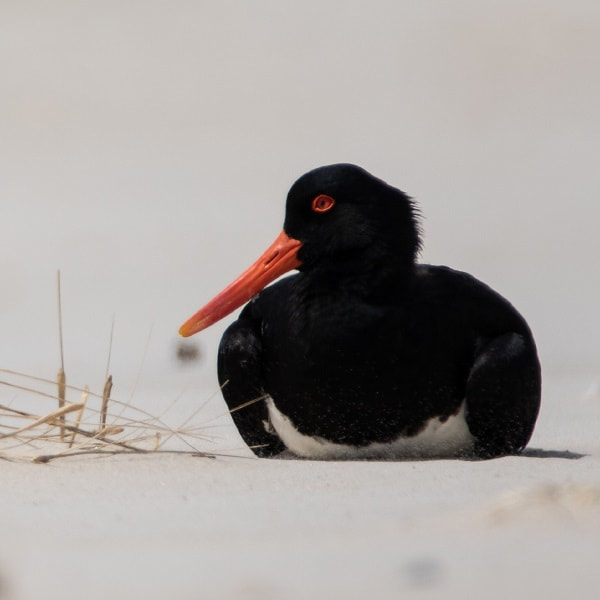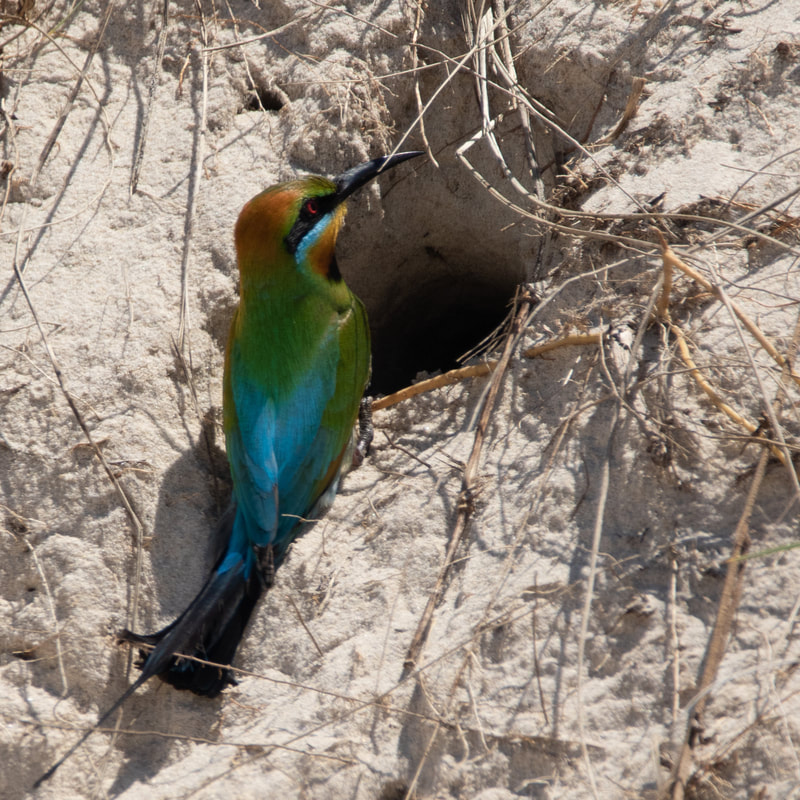Brooders in the dunes - Rainbow Bee-eaters, Pied Oystercatchers and Turtles
Whether you’re chillin’ with mates, building sandcastles with the kiddies or finding a quiet space for some zen time, our beaches provide us many opportunities for downtime and fun. And with the warmer months upon us, they’re about to become hives of activity!
Now, whilst ‘we’ rely on beaches for pleasure and sanity other species rely on them as places to procreate and brood new life. Take the rainbow bee-eaters for instance, these vivid green and orange birds have arrived from the north to spend the summer months here breeding, many have chosen our beach environments to set up house. Rainbow bee-eaters nest in sandy escarpments where they dig narrow tunnels with their bills and feet of up to 1m long. On the beaches, these can be seen on the fronts of the dunes and even on the sides of walking tracks – they look like large crab holes. At the end of each tunnel is a nesting chamber where mum, dad and other helpers share the task of incubating eggs and feeding chicks. Currently, there are active bee-eater nests all along seven mile beach.
Pied oystercatchers are another species who use beach environments to nest in. Listed as endangered in NSW, their nests are merely a scrape in the sand at the front of the dunes above high tide mark. They are particularly vulnerable to human disturbance. We do see a few pieds on seven mile beach but are unsure if they’ve chosen to nest here, so if you see a nest, please get in touch. The closely related all black, familiar ‘sooty oystercatcher’ nests on offshore islands, not on sandy beaches.
And then there are the turtles… who haul themselves up the sand, hopefully past the high tide mark, anytime from now till February each year to lay their eggs. We mainly see loggerheads and greens nesting locally. Their nests can go unnoticed unless fresh mumma tracks are present. Seabird Rescue are the ones to contact if you see a turtle nest and taking a photo of any track will help with ID.
Now, whilst ‘we’ rely on beaches for pleasure and sanity other species rely on them as places to procreate and brood new life. Take the rainbow bee-eaters for instance, these vivid green and orange birds have arrived from the north to spend the summer months here breeding, many have chosen our beach environments to set up house. Rainbow bee-eaters nest in sandy escarpments where they dig narrow tunnels with their bills and feet of up to 1m long. On the beaches, these can be seen on the fronts of the dunes and even on the sides of walking tracks – they look like large crab holes. At the end of each tunnel is a nesting chamber where mum, dad and other helpers share the task of incubating eggs and feeding chicks. Currently, there are active bee-eater nests all along seven mile beach.
Pied oystercatchers are another species who use beach environments to nest in. Listed as endangered in NSW, their nests are merely a scrape in the sand at the front of the dunes above high tide mark. They are particularly vulnerable to human disturbance. We do see a few pieds on seven mile beach but are unsure if they’ve chosen to nest here, so if you see a nest, please get in touch. The closely related all black, familiar ‘sooty oystercatcher’ nests on offshore islands, not on sandy beaches.
And then there are the turtles… who haul themselves up the sand, hopefully past the high tide mark, anytime from now till February each year to lay their eggs. We mainly see loggerheads and greens nesting locally. Their nests can go unnoticed unless fresh mumma tracks are present. Seabird Rescue are the ones to contact if you see a turtle nest and taking a photo of any track will help with ID.
So how do we share our beaches without impacting on these species? At risk of being the fun police here’s a few things to keep in mind;
*Many thanks this month to Rob Seal and Jan Olley for kindly sharing their local bird knowledge.
- Many nesting birds will leave their nests when disturbed. If left for too long eggs or young simply won’t survive. Eggs may get too hot or cold and chicks can starve or fall prey to natural predators. Parents will return when the disturbance has passed but it could be too late.
- Hungry, curious dogs can sniff out and demolish a bird or turtle nest in no time.
- Vehicles driving over turtle nests can compact the sand above, crushing eggs or making it hard for hatchlings to get out.
*Many thanks this month to Rob Seal and Jan Olley for kindly sharing their local bird knowledge.
Written by K.Saunderson, published November 2018.





